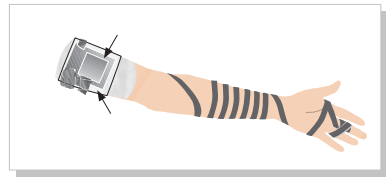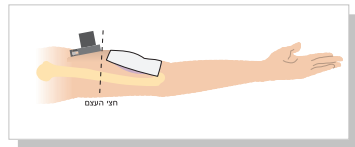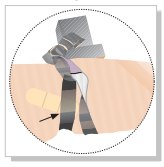Chapter 21: Wearing the Tefillin Directly on One’s Arm and Head Without a Hatzitzah
1) One must wear the tefillin shel rosh directly on one’s head and the tefillin shel yad directly on one’s arm; hence, one must ensure that there is nothing in between the tefillin and his arm or head.[113]
a. If there is dirt on one’s upper arm in the place where the tefillin shel yad is worn, he must wash and then thoroughly dry the area before donning tefillin.[114]
b. Some authorities maintain that overgrown hair constitutes a hatzitzah (interruption) between the tefillin shel rosh and one’s head. Although other authorities disagree, it is proper not to allow one’s hair to grow long, in order to fulfill the tefillin obligation according to all views. Moreover, Halachah requires that the tefillin shel rosh be tightly fastened around one’s head. Tefillin placed on overgrown hair generally hangs on the head, and cannot be tightly fastened. For this reason, too, one should ensure that his hair does not grow long. [115]
c. Strictly speaking, powder and conditioning gel do not constitute a hatzitzah between the tefillin and one’s hair or skin. Nevertheless, it is preferable to be stringent in this regard and not apply powder or conditioning gel to his arm or hair before donning tefillin.[116]
d. After having one’s hair cut, it is proper to wash the hair to remove the small pieces of hair that often remain and could constitute a hatzitzah in between the tefillin and one’s head. People with dandruff should thoroughly comb their hair before donning tefillin. Nevertheless, if this is not possible, one may rely on the authorities who do not consider dandruff or small hair remnants a hatzitzah. [117]
e. Due to the curvature of the head, part of the tefillin shel rosh is usually suspended slightly above the head, rather than resting directly on the head. This is perfectly acceptable, as the air in between the tefillin and the head does not constitute a hatzitzah. [118]
2) A person who wears a toupee must remove it before putting on the tefillin shel rosh. If this would cause him embarrassment, he should don tefillin at home without the toupee and recite the Shema while wearing tefillin. He should then go to pray in the synagogue and wear his tefillin over the toupee. If, however, the hair was permanently implanted onto his head, or if the toupee is attached and immoveable, it is considered his own hair and does not constitute a hatzitzah; one may thus wear tefillin shel rosh over such hair without concern.[119]
3) The following are the guidelines for one who has a bandaged wound on the head, where the tefillin shel rosh is worn, or on the upper arm where the tefillin shel yad is worn:
a. If one has a wound on his head and cannot wear tefillin directly on the wound, he may wear the tefillin over the bandage. In such a case, halachah allows one to rely on the view of the Rashba, who held that a foreign substance in between the body and the tefillin does not disqualify the mitzvah.

If possible, he should endeavor to remove the bandage for the recitation of Shema and the Amidah. One who must wear tefillin over a bandage should cover it so that people do not mistakenly conclude that the tefillin shel rosh need not be worn directly on the head. If in such a case the person does not, for whatever reason, wear the tefillin shel yad, he does not recite a berachah over the tefillin shel rosh.[120]
b. If the wound is on the upper arm, where the shel yad is worn, then ideally, the bandage should be temporarily removed so that the tefillin may be worn directly on the arm. Similarly, a person who must have his arm placed in a cast should, when possible, ensure that the cast does not extend to the upper arm where the tefillin shel yad is worn.
c. If the bandage cannot be removed or the cast extends to the upper arm, then one should place the tefillin over the bandage or cast, and ensure to cover the

tefillin with his sleeve. In such a case, he does not recite a berachah before donning the tefillin shel yad; instead, he should recite the berachah of על מצות תפילין over the tefillin shel rosh and have in mind for this berachah to apply to the shel yad, as well.[121]
d. If the bandage or cast covers only the lower half of the muscle on the upper arm, while the upper half

remains exposed, then the tefillin should be worn on the upper part of the muscle.[122]
e. If one cannot wear tefillin on his left arm at all, due to the immense pain he would experience or the damage that the tefillin could cause to the injured area, then he does not wear tefillin shel yad at all. Preferably, however, he should don tefillin on his right arm without a berachah.[123]
4) It is proper to ensure that nothing comes in between the straps of the tefillin shel rosh and one’s head, and between the straps of the tefillin shel yad and one’s upper arm. According to some authorities, one should also ensure that nothing comes in between the seven wrap cirucuits on the forearm and the skin of the arm. Beyond the seven wrap circuits, however, it is not necessary for the straps to be wrapped directly on one’s skin. Thus, strictly speaking, it is not necessary to remove one’s wristwatch before laying tefillin. Nevertheless, it is commendable to act stringently in this regard and remove one’s wristwatch before donning the tefillin shel yad.[124]
5) If a person has a bandage on the upper arm in the place

where the strap of the tefillin shel yad is wrapped, he may don tefillin as usual, wrapping the strap on the bandage, and may even recite a berachah, as halachah treats the straps more leniently than the bayit in this regard. (He should make a point of covering the tefillin shel yad, as mentioned earlier.) This applies to the strap of the tefillin shel rosh, as well: one may don tefillin as usual with a berachah even if there is a bandage on his head underneath the strap of the tefillin shel rosh.[125]

Footnotes
- 113 - שו"ע כז:ד
- 114 - משנ"ב וכה"ח שם
- 115 - משנ"ב כז:ד
- 116 - כה"ח שם
- 117 - ילקוט יוסף
- 118 - שם
- 119 - אגרות משה או"ח ח"ד סי' מ
- 120 - שו"ע כז:ה, ומשנ"ב וכה"ח שם
- 121 - משנ"ב שם
- 122 - משנ"ב כז:ז וכה"ח שם
- 123 - עיין פמ"ג שכתב שיוצא עכ"פ למ"ד הנחה ביד שמאל לא הוי לעיכובא.
- 124 - משנ"ב כז:ד, ילקוט יוסף
- 125 - משנ"ב כז:ד

